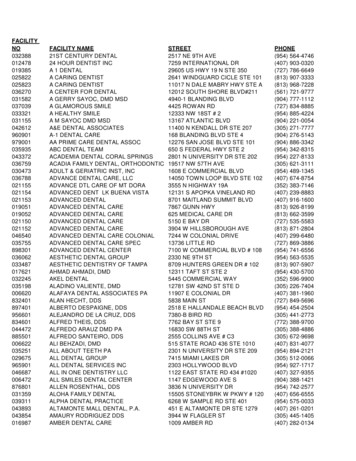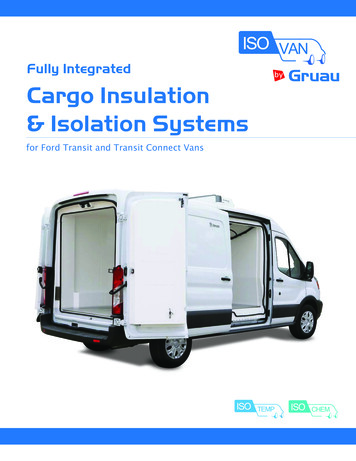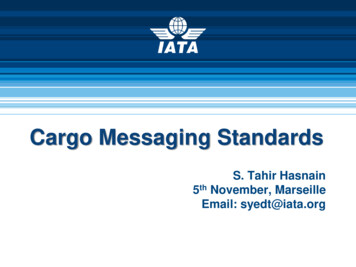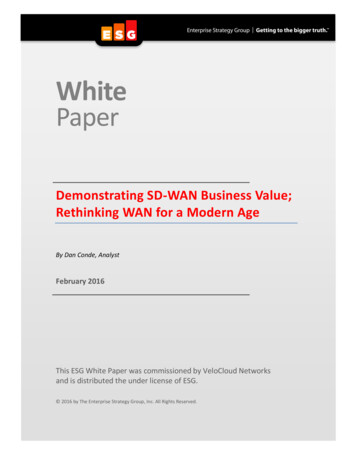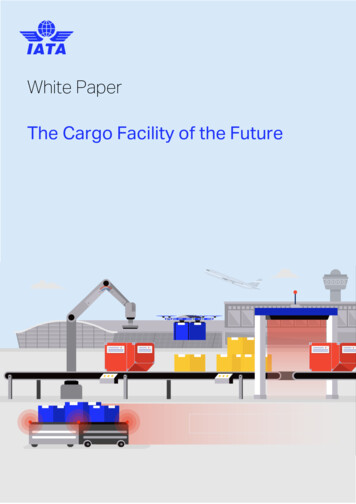
Transcription
White PaperThe Cargo Facility of the Future
The Cargo Facility of the FutureWorld air cargo traffic is forecast to increase dynamically,with the annual growth rate over 4% in the next 20 years. Inthat, air freight is projected to grow at a rate of 4.3% perannum while airmail will grow at an average rate of 2%.20%e-commerceannual growthAir cargo market is and will besignificantly stimulated by the boomof e-commerce, with its marketsize forecast to increase 20% perannum during the next five years, toabout 5 trillion in 2021.More special commodities, less letters, more parcels,more periods of high demand illustrates a shift in thetype and volume of goods handled through cargo facilities.Transportation of letters decreased from 340 to 328billion globally, whereas the number of postal parcelsgrew from 6.7 to 7.4 billion.Shippers, freight forwarders and logistics providersincreasingly demand or expect excellence, simplicity,traceability, transparency and speed.Regulations impacting air cargo will continue to increase,though ideally, they will be smart, balanced and datadriven.2The Air Cargo Facility of the FutureAir cargo will continue to evolve,cargo facilities must keep paceEconomic outlook, increasing customer expectations andchanging regulations are redefining the handling, storageand distribution of goods transported by air whichconsequentially impacts cargo facilities. Changes aretherefore needed in business models, architectural andprocess designs, deployed technologies and workforceskillsets.Fully automated high-rackwarehouses, automated and greenvehicles navigating autonomouslythrough the facility, employeesequipped with tools, includingArtificial Intelligence (AI) andAugmented Reality (AR),empowering them to be moreefficient – the next generation oftechnology-enhanced cargo facilities will boostproductivity, operational efficiencies and increaseresponsiveness to customers.Many facilityoperations willbecomeautomated by2030The cargo facility of the future will be safe and secure,green, automated, connected and smart. This will ensurethe cargo facility of the future is fit for purpose in size,location and for the people who use itMarch 2019
Six technology trendsrevolutionizing aircargo facilities3AUGMENTED REALITY ANDWEARABLESDRONES AND AUTONOMOUSVEHICLESROBOTICS AND AUTOMATEDSYSTEMSBIG DATA / PREDICTIVEARTIFICIAL INTELLIGENCE / DEEPLEARNINGIOT, CONNECTED CARGO ANDDEVICESGREEN, SUSTAINABLE, NET ZEROBUILDINGSThe Air Cargo Facility of the FutureMarch 2019
The Cargo Facility of the Future will be Safe and Secureincluding rain water from roofs and tarmac, treated wastewater and recycled cooling water.The cargo will be secured upstream with a combination oftechnology and data used to confirm security statusthroughout the process up to and within the facility. Whennecessary, extra controls will be flagged and plannedaccordingly.Green facilities will protect their owners from traditionalenergy price increases and carbon emissiontaxes/penalties, resulting in overall cost reductions.Screening equipment onsite will be designed specificallyfor air cargo and integrated into the process, so that noadditional steps or touch points are required.Information gained fromscreening will be used toautomatically validateavailable booking data andscanned shipmentdocumentation to ensureconformity of the cargo.Molecular screening will becapable of processing allcommodities including lithium batteries, live animals andpharmaceuticals and will perform multiple actions such assecurity screening, commodity specific identification,safety checks in a fast and lean process. This will allow forthe identification of drug integrity, potency as well asidentification of live animal species but also the detectionof prohibited materials such as illegal ivory artifacts atinterfacing points in the supply chain.GreenEnvironmental stewardshipwill be as important assafety and security. With theappropriate policies,strategies and shared bestpractices, cargofacilities will contribute toaviation’s overallenvironmental impactreduction targets, such ascarbon neutral growth by 2020 and halving net emissionsby 2050 based on 2005 levels.Emissions will be reduced via progressive fleetmodernization, use of zero or low emission alternativessuch as electric vehicles and solar panels, and operationalefficiencies. Water and land use will be optimized, wastewill be efficiently managed through the “reduce, reuse,recycle” waste hierarchy. Where possible, potable wateruse will be replaced with water from other sources4The Air Cargo Facility of the FutureSingle-use plastics, such as shrink wraps, protectivecovers will be replaced with suitable alternatives whosetotal impact assessment lowers the footprint whilemaintaining efficiency.AutomatedAutomation will be taken tonew heights withautonomous vehicles,robotic systems and drones,allowing operations toaccomplish more each day.Productivity, precision andquality will be enhanced,process waste removed,and speed increased.Autonomous material handling equipment will weigh, dim,take acceptance photos and automatically move the cargoto the next location. Drones will manage automated sortingand inventory management. Automated build-up andbreak-down of cargo will be performed by roboticsystems.Robots will also eliminate human tasks that are dangerous,repetitive or tedious, such as dealing with toxic spillage,handling over-sized or extremely fragile cargo.Replacing the storage rackfunction (i.e. a buffer) withautomated lift devices, orautomated storage andretrieval (AS/RS) devicesallows for the racks to becloser together, as well asfrees up time for personnelto continue the tasks stillbeing performed by humans.Robots then work alongside the human, not just to help therobots learn the tasks, but also to supplement where therobot is less efficient and vice-versa. The added benefit isthe ability to reduce the horizontal footprint thoroughthese efficiency gains. Augmented Reality will reduceerrors, improve processing times, improve user/ workerMarch 2019
satisfaction and reduce training and ongoing competencyassessment burdens.ConnectedIdentifying, tracking,monitoring, interacting witheverything, everyone andeverywhere in thewarehouse will be madepossible by the use ofmobile and connecteddevices, sensors and dataloggers combined with theInternet of Things.Sensors will capture and display transport and handlinginformation as well as required electronic documentation.The status of assets, commodities, parcels, environmentalconditions, locations and people will be monitoredthroughout the journey and made available in real-time toall required systems and handling staff via AR devices.Cargo will be interactive!SmartData collected from sensors, electronic documents,screening methods or captured from oral discussionswithin the facility will be processed and consumed by AIbased systems, providing tools to empower humanworkers to be more efficient.5The Air Cargo Facility of the FutureAI analysis results will thenbe fed back to warehousemanagement systems,voice-controlled assistantsor smart glasses in order tooptimize the facilityoperations and assetutilization overall for humancomfort and energyefficiency.“Internet of Cargo” in the facility will contribute to internalprocess optimization, better predictability of maintenanceneeds for the handling equipment and improvement ofemployees’ health and safety; overall resulting in costreductions.With connected and smart facilities, customers will bemore engaged, receive greater transparency on theservices offered, benefit from complete traceability andwill interact in real-time when necessary. This will ultimatelyhelp increase their overall satisfaction.Deep learning could also be used to train a combined AIand AR system to recognize more complex scenarios oroperations. A view of special loads to be shipped, forexample, could suggest a securing approach to staff, withinstructions, tests, and approved tolerances immediatelypinpointed on the image.March 2019
IATA’s role to drive innovation in operational efficiencyIATA is the trade association representing approximately275 commercial airlines worldwide, accounting for morethan 83% of total air traffic. IATA’s mission is to represent,lead and serve the airline industry.Air cargo represents more than 35% of global trade byvalue. When it comes to combined passenger and cargoairlines, the cargo business generates 9% of airlinerevenues on average, representing more than double therevenues from the first-class segment.To support this critical business, IATA is committed todeliver enhanced value for the industry by driving a safe,secure, profitable and sustainable air cargo supply chain.IATA develops global standards and tools, offers financialservices and industry solutions, drives transformationprojects, creates partnerships and runs campaigns,advocacy and outreach activities.IATA is driving change in the air cargo industry bysimplifying the business and helping make air cargo easier,faster and smarter. Our objective is to strengthen todaywith a portfolio of transformational projects and build6The Air Cargo Facility of the Futuretomorrow with a framework to foster longer-terminnovation for the benefit of the IATA member airlines andthe air cargo industry through: White papers to inform readers concisely about acomplex issue and present IATA's positions andrecommendations on the matter.The IATA Air Cargo Innovation Awards organizedevery two years to support innovative ideas.Innovation groups and events with air cargodecision makers, investors, customers to shapethe industry’s future.Like many other industries, aviation tends to focus onaddressing immediate challenges, as opposed to engagingin deep reflection as to what the future holds and how itmight affect the industry or particular airlines.While the future is unpredictable, there are steps we cantake to be better prepared for what it may bring. With itsframework to drive innovation, IATA wants to equip itsmember airlines and the air cargo industry with insightsand tools each individual commercial player can add totheir strategic thinking to gain a competitive edge.March 2019
IATA’s pipeline of initiatives supporting innovation incargo operationsEXPLORATORY WORKFACE Vision 2030Automated vehicles at airportsA white paper produced by the future air cargo leaders, theFACE community, to make their voice heard on their longterm vision for the industry.A paper exploring thetransformative potentialof the use of automatedvehicles at airports.Air Cargo and e-Commerce Enabling Global TradeA white paper on how the air cargo industry is addressinge-commerce, and IATA’s role driving these initiatives.Augmented Reality in Air Cargo Proof of ConceptA proof of concept trialto show thataugmented reality canwork to reduce errors,improve processingtime and improveworker satisfaction.Innovative screening technologiesEncouraging the development of new cost-efficientequipment and methodologies to automatically screen alltypes and all sizes ofgoods, includingdangerous goods,which are simple tobuild into operationand complying withregulatorycertification.Drones for tomorrow’s air cargoDeveloping therelevant standards,guidelines andpartnerships for thesafe integration of thisnew branch of civilaviation into thecommercial air spaceto open newopportunities for theair cargo industry.Smart ULDEncouraging developmentof next-generation, smart,connected ULDs to servethe air transport industry.PROJECTS,Creating transparency in cargo handling services and theirquality, as well as enhancing handling capabilities to aconsistently high standard across the industry.Interactive CargoDeveloping the relevant standards and guidelines (piecelevel tracking, real-time notification, and use of connecteddevices) to enable cargo to talk!NEXTTNew Experience Travel Technologies (NEXTT) is a jointIATA and ACI initiative to develop a common vision toenhance the on-ground transport experience, guideindustry investments and help governments improve theregulatory framework.7Smart FacilityThe Air Cargo Facility of the FutureCargo & mail IT systems mappingBringing together the two different systems to comply withregulatory and operational requirements in an efficient andautomated way without disrupting the flow of goods.March 2019
PRODUCTS & SERVICESDG AutoCheckIATA Cargo Handling Manual (ICHM)IATA’s new dangerous goods acceptance check validationtool that takes all the regulations, rules, best practices andguidance contained in the IATA Dangerous GoodsRegulations (DGR) and converts them into an automatedcompliance solution.Describing industry best-practices, aligned to the IndustryMaster Operating Plan and international regulations andstandards, ICHM is the first complete set of standardscovering the operational activities of all stakeholders in thesupply chain.RampVRThe aviation industry’s first virtual training platform forground operations, RampVR allows participants toexperience a variety of scenarios in different operatingconditions, using high-spec virtual reality technology.www.iata.org/cargo-facility8The Air Cargo Facility of the FutureMarch 2019
White papers to inform readers concisely about a complex issue and present IATA's positions and recommendations on the matter. The IATA Air Cargo Innovation Awards organized every two years to support innovative ideas. Innovation groups and events with air cargo decision makers, investors, customers to shape the industry’s future.

